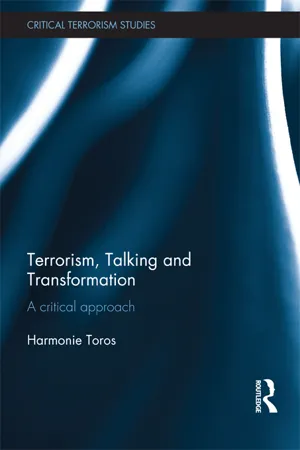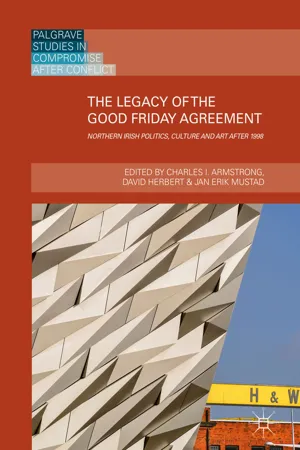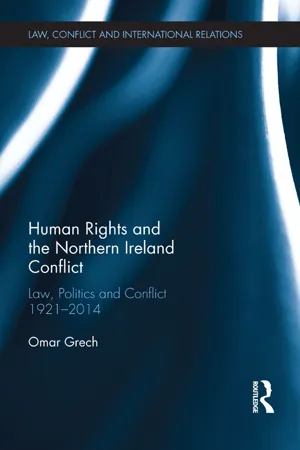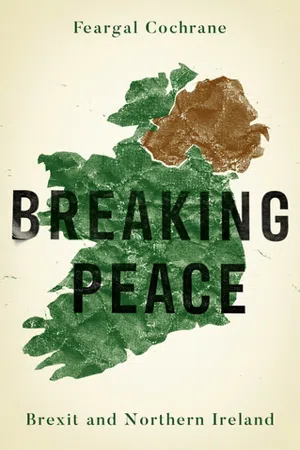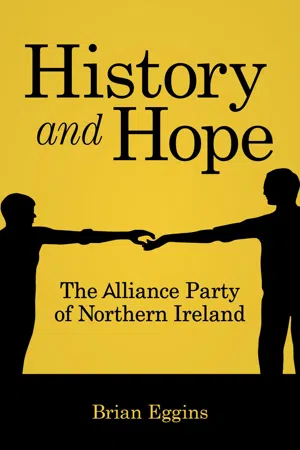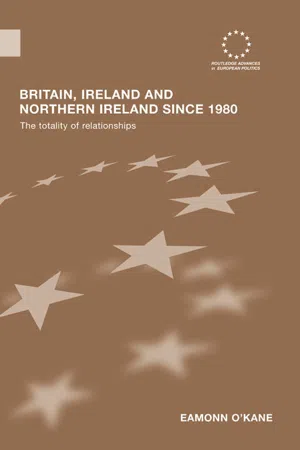History
Good Friday Agreement
The Good Friday Agreement, also known as the Belfast Agreement, was signed in 1998 to bring an end to the conflict in Northern Ireland. It established a power-sharing government and addressed issues such as decommissioning of paramilitary weapons, human rights, and justice. The agreement has been instrumental in maintaining peace and stability in the region.
Written by Perlego with AI-assistance
Related key terms
7 Key excerpts on "Good Friday Agreement"
- eBook - ePub
Northern Ireland
Conflict and Change
- Jonathan Tonge(Author)
- 2013(Publication Date)
- Routledge(Publisher)
Chapter 14The Good Friday Agreement
DOI: 10.4324/9781315837871-14The climax of the peace process arrived in April 1998, as political agreement was reached. The Good Friday (or Belfast) Agreement represented the culmination of exhaustive multi-party, intergovernmental and bilateral talks. Although the talks process was not entirely inclusive, the DUP and UKUP declining to participate, the majority of Northern Irish opinion was represented. The Agreement reflected hard bargaining among historical enemies, allied to compromise. At its heart lay the principle of consent for constitutional change in Northern Ireland. Within this overarching principle lay power-sharing, all– Ireland and confederal dimensions, alongside continued intergovernmentalism. A broad sketch of the constitutional agenda of the Good Friday Agreement had been visible at Sunningdale 25 years earlier. For the new Agreement to form the endgame, a new inclusiveness on non-constitutional issues was needed, embracing an equality agenda and ‘end of conflict’ measures, such as paramilitary prisoner releases.14.1 The contents of the Agreement
The Agreement contained several Strands. These were:- Strand 1: a devolved Northern Ireland Assembly of 108 seats, presided over by a cross-community Executive and headed by a First Minister and a Deputy Minister;
- Strand 2: a North-South Ministerial Council, to establish all-Ireland implementation bodies in at least six policy areas;
- Strand 3: a British-Irish Council, comprising representatives from the British and Irish governments, alongside those from devolved institutions in the United Kingdom. A British-Irish intergovernmental conference, designed to explore the totality of relationships between the two islands, replaced the Anglo-Irish Agreement.
The Irish government also dropped its constitutional claim to Northern Ireland. Henceforth, Articles 2 and 3 of the constitution of the Irish Republic would contain a mere aspiration, rather than assertion, of Irish unity. Aside from constitutional issues, the Agreement also covered human rights, equality, decommissioning, prisoners, security and policing. The main equality-oriented measures were: - eBook - ePub
- Harmonie Toros(Author)
- 2012(Publication Date)
- Routledge(Publisher)
not aim to assert that talking was the only factor in the transformation of the conflict or that talking can be isolated as a causal factor in ending terrorist violence. On the contrary, it aims to place talking within its socio-historical context and, while concentrating on a narration of talking, to examine what enabled and constrained the talking and how the engagement was linked to other processes occurring at the same time. It is the tale of one story of Northern Ireland. This is not to say that there are no other stories that can be told about this period. The aim is simply to tell one important and understudied story.This research will focus on a ten-year period from 1988 to the signing of the Good Friday Agreement in April 1998. The reason for this choice is three-fold. First, it represents the period of most intense talking during the Troubles. This is particularly true when examining talking with the republican movement. The talks between Sinn Féin's Gerry Adams and the nationalist leader John Hume started in 1988, as did contacts between Sinn Féin and the Irish government, followed by secret talks with British officials.This timeframe is also the period that arguably saw the greatest change in perception of Sinn Féin and the IRA, which went from being seen (outside the republican and to some extent nationalist circles) as a shunned pariah, to being accepted as a recognized (although not fully) participant in the peace and political process. It also saw the greatest change in the republican perception of the British, who went from being perceived as the masterminds of a dirty war aimed at keeping Ireland British to a power that could eventually allow for a united Ireland if a majority in Northern Ireland were to support such a transformation.The third reason for examining this period is because it led to the Good Friday or Belfast Agreement. Although there is still debate over the agreement and whether it had a real transformative effect on the conflict, there is little doubt that it marked a turning point in the reduction of terrorist/counterterrorist violence, sealed the paramilitary ceasefires, and at least attempted to launch a process of structural transformation. The significance of the agreement will be discussed in detail at the end of the chapter, where I will examine how it enabled a series of initiatives based on talking, including the coming together of current and former paramilitaries across the conflict divide to reduce violence on tense interfaces in Belfast. - eBook - ePub
The Legacy of the Good Friday Agreement
Northern Irish Politics, Culture and Art after 1998
- Charles I. Armstrong, David Herbert, Jan Erik Mustad, Charles I. Armstrong, David Herbert, Jan Erik Mustad(Authors)
- 2018(Publication Date)
- Palgrave Macmillan(Publisher)
Servants of the People: The Inside Story of New Labour . London: Hamish Hamilton.Trimble, D. (2007, April 24). Antony Alcock Memorial Lecture. University of Ulster. Available at http://www.davidtrimble.org/speeches_alcock.pdf .Whyte, J. (1990). Interpreting Northern Ireland . Oxford: Oxford University Press.Passage contains an image
© The Author(s) 2019Begin AbstractC. I. Armstrong et al. (eds.)The Legacy of the Good Friday Agreement Palgrave Studies in Compromise after Conflict https://doi.org/10.1007/978-3-319-91232-5_44. ‘George Mitchell’s Peace’: The Good Friday Agreement in Colum McCann’s Novel TransAtlantic
Charles I. Armstrong1(1) University of Agder, Kristiansand, NorwayKeywords Mitchell McCann Negotiation Heroism Peace process Fiction StorytellingEnd AbstractIntroduction
The 1998 Good Friday Agreement was the result of a complicated history involving many different parties. The way in which some aspects of it—including the power-sharing mechanism—are anticipated by the 1973 Sunningdale Agreement suggests that certain features of the later deal were if not inevitable, then at least overdetermined. By 1997, Jonathan Powell notes, most ‘of the moving parts in a Northern Ireland settlement had been on the table for years or even decades’ (Powell 2008 , 12). Yet the role of the different political players—particularly the Republican and Unionist parties, and their political representatives, as well as the various governments and their leaders—should not be underestimated. Certainly, there is no dearth of accounts of the Troubles that suggest that the political leadership of individuals played an important or even crucial role, on the way towards peace. Tim Coogan, for instance, has surprisingly suggested that Pope John Paul II, during his visit to Ireland in September 1979, ‘sowed the seeds of the IRA ceasefire of fifteen years later, even though no one, not even the IRA, was aware of the fact’ (Coogan 1996 , 385). The awarding of the Nobel Peace Prize to David Hume and John Trimble in 1998 tells a different, and more conventional, story whereby the risky sacrificing of tribal antagonisms by leaders of the two warring sides or communities is given main emphasis. On the other hand, the earlier award of the Peace Prize to Betty Williams and Mairead Corrigan tells yet another story, emphasizing grassroots initiatives, albeit still one where the individual takes a prominent role. Even though earlier British prime ministers had, to some degree, already paved the way, Tony Blair’s crucial role—building upon the political leeway granted by his landslide election victory in 1997—has of course also been acknowledged. Blair himself has highlighted the role of individuals—‘Different and lesser people would have never accomplished this’, he declares (Blair 2013 - eBook - ePub
Human Rights and the Northern Ireland Conflict
Law, Politics and Conflict, 1921-2014
- Omar Grech(Author)
- 2017(Publication Date)
- Routledge(Publisher)
6 Peace and human rights, 1985–1998 The long thawIntroduction
This chapter addresses three themes which span the timeframe between the signing of the Anglo-Irish and Good Friday Agreements. The three themes relate to: (1) a number of entrenched human rights challenges in Northern Ireland (and the ways in which they continued to be addressed); (2) the role of human rights concerning conflict resolution negotiations; and (3) the extent to which the conflict resolution efforts in Northern Ireland were more concerned with ending physical violence (negative peace) than with building positive peace (including a deep commitment to and engagement with human rights).The period under examination spans the immediate aftermath of the hunger strikes and Sinn Féin’s increasing electoral activism to the negotiations which led finally to the Peace Agreement of 1998. This period was one characterised by continuing violence, continuing negotiations and increasing hopes for a political settlement. In some ways, this period reflected both continuity and hope for change in Northern Ireland. Continuity was evident in the enduring violence1 perpetrated by republican and loyalist paramilitaries (and occasionally the security forces of the UK) as well as by a continuing concern with human rights issues which had bedevilled Northern Ireland since the 1920s. These human rights concerns centred, inter alia, on: the use of special powers legislation and problems relating to the administration of justice;2 religious discrimination (particularly in employment);3 and the whole area of cultural rights and their expression in terms of the use of flags, emblems and parades.4Hopes for change in the period gradually increased as the 1980s drew to a close and the 1990s dawned. These prospects for change were driven by numerous factors, including the new leadership in both London and Dublin with John Major and Albert Reynolds making sustained efforts at breaking the political deadlock. Other factors included an increasing belief within the republican movement that the political avenue was worth pursuing and a contemporaneous sense of conflict fatigue emerging within the IRA, loyalist paramilitaries and UK security forces.5 With politics gradually becoming a more feasible and attractive option to all parties, the possibility of ending violence became more real than ever. The 1990s, therefore, witnessed long, arduous and hesitating negotiations which finally led to the 1998 Northern Ireland Peace Agreement. Throughout this period, human rights issues formed part of the discourse that coloured the negotiation process, as was evident in the various official communications that emanated from the UK and Irish governments.6 While human rights concerns were referred to continuously, they did not in themselves prove to be the primary issues in the negotiations. As accounts of the negotiations demonstrate, the key contentious issues during the negotiations proved to be decommissioning, the scope and functions of North–South bodies and to a lesser extent the exact functioning of power-sharing.7 - eBook - ePub
Breaking peace
Brexit and Northern Ireland
- Feargal Cochrane(Author)
- 2020(Publication Date)
- Manchester University Press(Publisher)
Clinton's message was a hopeful one but cast the GFA and its institutions as fragile and requiring further compromise from politicians and their supporters for peace to be fully realised: ‘voters have to stop punishing people who make those compromises. And start rewarding them.’ 9 The leader of the SDLP, Colum Eastwood, commented when giving evidence to the Northern Ireland Affairs Committee on 21 February 2018, ‘the Good Friday Agreement is recognised as a contrivance – but so is Northern Ireland’. 10 Academic learned societies such as the Political Studies Association (PSA) ran podcasts and commissioned blog pieces from numerous academic specialists on the legacy of the GFA, 11 and broadcast and print media around the world also marked the occasion. A large number of these contributions considered Brexit, and the negative implications this could have for the Irish border and the peace process in Northern Ireland more broadly. 12 A former Irish ambassador spoke of his concern to write up his reflections on the Good Friday Agreement while it still had a shelf life as in his view, Brexit was suffocating it. It was still the ‘gold standard’ reference point in the peace process, but he suggested that this would not last forever if Brexit continued to hollow out Anglo-Irish relations and the interparty relationship in Northern Ireland. 13 The Brexit meteor crashed into the already unstable political fabric of Northern Ireland in a way that unearthed questions that had been submerged since the GFA was finalised in 1998. Chief among those was the constitutional question and the accepted wisdoms woven into the political and legal fabric of the GFA - eBook - ePub
History and Hope
The Alliance Party of Northern Ireland
- Brian Eggins(Author)
- 2015(Publication Date)
- THP Ireland(Publisher)
6
‘Problems and setbacks’: Implementing the Good Friday Agreement 1998–2005
INTRODUCTION
Despite the success of setting up the Good Friday Agreement, there were many problems in implementing it, mainly concerned with decommissioning of IRA weapons. It led to disagreements within the UUP and the beginnings of its subsequent decline, as some members disagreed with David Trimble’s policies and left to join the DUP. At the same time the Alliance Party was also having very mixed electoral fortunes. A major survey of Alliance members and subsequent analysis by Evans and Tonge191 predicted a decline and suggested a merger with the Unionists. Despite, or because of these factors, there was a major review of Alliance Party mission, aims and objectives carried out in 1998. At the end of this process there were some signs of renewal of fortunes.PROBLEMS OF ‘DECOMMISSIONING’ & DESIGNATIONS
The Alliance Party representatives at the Forum were cock-a-hoop when the referendum went in favour of the Agreement that they had helped to negotiate on Good Friday 1998. Indeed a photograph appeared in The New York Times showing the Alliance Party celebrating the results of the referendum with party leader John Alderdice spraying champagne! They had jollied and pushed and persuaded the other parties to come to an agreement that included Sinn Féin (linked to the IRA) across to the PUP (linked to the UVF), but excluding Paisley’s DUP. At the end Geoffrey Donaldson of the UUP ominously did not go along with his party’s acceptance and later joined the DUP.There was still unfinished business, principally the decommissioning of IRA arms, but no mention at that stage of Loyalist arms. Despite that, the prisoners on both sides were to be released on licence in order to keep those with paramilitary wings on board.But much had been sacrificed by the Alliance Party against its own interests. Although many features of the (by then) rather dated ‘Governing with Consent’ were included, the Agreement was a carve-up, that entrenched the sectarian divisions, so that voting in the subsequent Assembly required 50% of Nationalists and 50% of Unionists to pass appropriate legislation, known as ‘parallel consent’. The appointment of ministers was not to be done by cross-community voting in the Assembly, but by the strange d’Hondt method, introduced by Mark Durkan of the SDLP (according to himself). That arrangement effectively left Alliance disenfranchised, as they rightly refused to consider themselves belonging to either camp, but were given the designation ‘Other’, after appealing to the prime minister, though they would have preferred to be called ‘Centre’. Their votes were not to count, except in the overall total. - eBook - ePub
- Eamonn O'Kane(Author)
- 2012(Publication Date)
- Routledge(Publisher)
The Guardian, 31 March 1999).Whatever problems and divisions were to occur as a result of the ambiguity surrounding decommissioning the move did indeed make the GFA possible. The two governments had succeeded in effectively co-sponsoring negotiations that led to an agreement that was widely seen as likely to end the conflict in Ireland. It was an incredible achievement.Implementing the GFAThe two governments and the pro-agreement parties worked hard to convince the people to endorse the deal in simultaneous referenda North and South on 22 May and the people of the South to ratify the amendment of articles 2 and 3 of the Irish constitution.The doubts that many Unionists had over the agreement did not prevent the deal being approved. Blair himself though acknowledged that the decision to back the GFA had been a difficult one for many when he stated, ‘The people of Northern Ireland have shown courage and vision. I know some have voted with deep misgivings. I accept my duty to answer those misgivings’ (The Observer, 24 May 1998). The cause of this concern was polling which suggested that whilst up to 99 per cent of Catholics had voted in favour of the GFA the protestant community was very divided on the issue with the DUP claiming that a majority had voted against it and Trimble claiming that a narrow majority had backed the deal. The problem for pro-agreement Unionists was that protestant support for the GFA would continue to decline over the coming years ultimately leading to a sea-change in Unionist politics. Ian Paisley and the DUP were widely portrayed as politically irrelevant at the time of the GFA conclusion. According to Ronan Fanning, ‘poor Dr Paisley, he resembles nothing so much as a beached whale, a once fearsome Moby Dick who now excites only pity as he thrashes about in the shallows’ (Sunday Independent
Learn about this page
Index pages curate the most relevant extracts from our library of academic textbooks. They’ve been created using an in-house natural language model (NLM), each adding context and meaning to key research topics.

